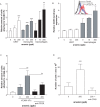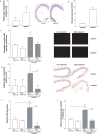Arsenic Exposure Increases Monocyte Adhesion to the Vascular Endothelium, a Pro-Atherogenic Mechanism
- PMID: 26332580
- PMCID: PMC4557830
- DOI: 10.1371/journal.pone.0136592
Arsenic Exposure Increases Monocyte Adhesion to the Vascular Endothelium, a Pro-Atherogenic Mechanism
Abstract
Epidemiological studies have shown that arsenic exposure increases atherosclerosis, but the mechanisms underlying this relationship are unknown. Monocytes, macrophages and platelets play an important role in the initiation of atherosclerosis. Circulating monocytes and macrophages bind to the activated vascular endothelium and migrate into the sub-endothelium, where they become lipid-laden foam cells. This process can be facilitated by platelets, which favour monocyte recruitment to the lesion. Thus, we assessed the effects of low-to-moderate arsenic exposure on monocyte adhesion to endothelial cells, platelet activation and platelet-monocyte interactions. We observed that arsenic induces human monocyte adhesion to endothelial cells in vitro. These findings were confirmed ex vivo using a murine organ culture system at concentrations as low as 10 ppb. We found that both cell types need to be exposed to arsenic to maximize monocyte adhesion to the endothelium. This adhesion process is specific to monocyte/endothelium interactions. Hence, no effect of arsenic on platelet activation or platelet/leukocyte interaction was observed. We found that arsenic increases adhesion of mononuclear cells via increased CD29 binding to VCAM-1, an adhesion molecule found on activated endothelial cells. Similar results were observed in vivo, where arsenic-exposed mice exhibit increased VCAM-1 expression on endothelial cells and increased CD29 on circulating monocytes. Interestingly, expression of adhesion molecules and increased binding can be inhibited by antioxidants in vitro and in vivo. Together, these data suggest that arsenic might enhance atherosclerosis by increasing monocyte adhesion to endothelial cells, a process that is inhibited by antioxidants.
Conflict of interest statement
Figures





References
-
- Abernathy CO, Thomas DJ, Calderon RL (2003) Health effects and risk assessment of arsenic. J Nutr 133: 1536S–1538S. - PubMed
-
- Nordstrom DK (2002) Public health. Worldwide occurrences of arsenic in ground water. Science 296: 2143–2145. - PubMed
-
- WHO W (2008) Guidelines for drinking-water quality [electronic resource] 3rd ed. Geneva. pp. Chemical fact sheets pp. 306–308b.
-
- ATSDR (2006) Toxicological Profile for Arsenic. Federal-Provincial-Territorial Committee on Drinking Water of the Federal-Provincial- Territorial Committee on Health and the dfvdEnvironment Guidelines for Canadian Drinking Water Quality: Guideline Technical Document:. Department of Health and Human Services, Public Health Service.
-
- HealthCanada (2006) Guidelines for Canadian Drinking Water Quality: Guideline Technical Document—Arsenic. Water Quality and Health Bureau, Healthy Environments and Consumer Safety Branch, Health Canada, Ottawa, Ontario:
Publication types
MeSH terms
Substances
Grants and funding
LinkOut - more resources
Full Text Sources
Other Literature Sources
Medical
Miscellaneous

